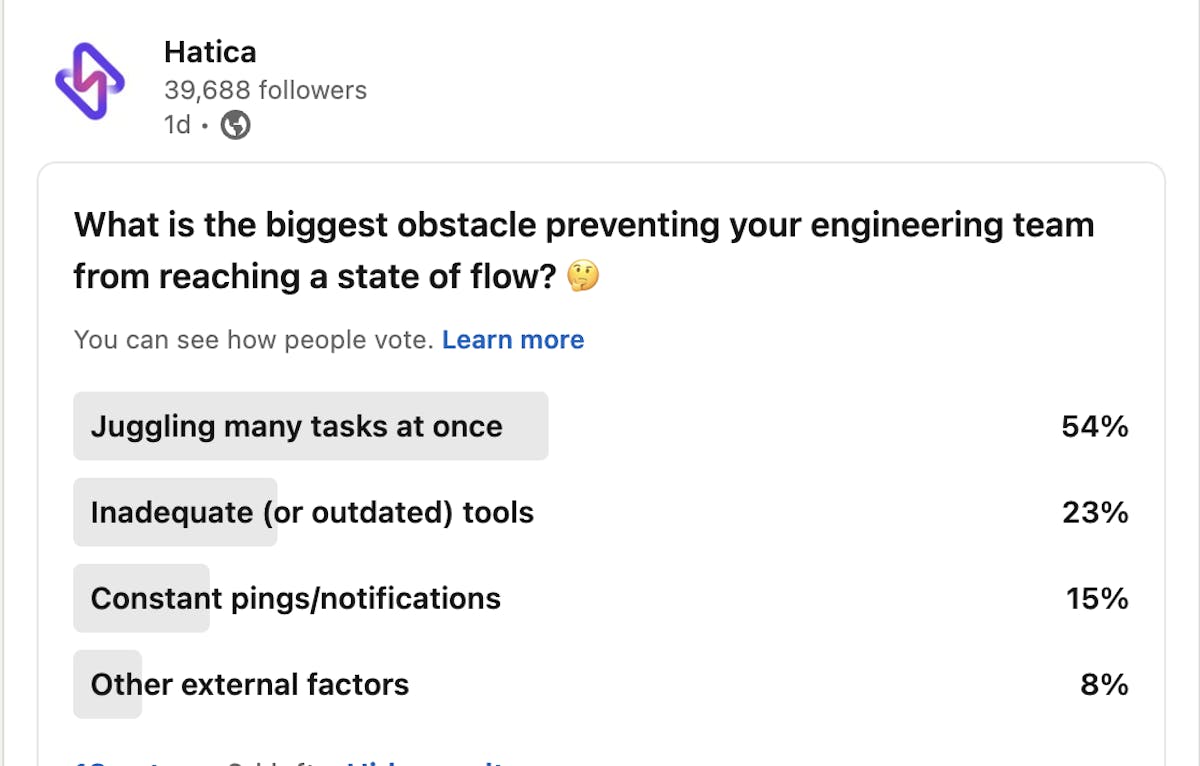Crafting code is more than just a task; it's an art form that demands deep concentration and unwavering focus. Every line of code, every debugging session, every code review—each step requires precision and meticulous attention to detail.
However, in today's digital age, maintaining such focus is no easy feat. Constant notifications and messages bombard us, making it all too easy to lose our train of thought and momentum while coding.
If you're tired of the miscommunications, delays, and stalled projects that often plague teams, it's time to implement the concept of Flow within your development practices. This practical approach serves as a guide to aligning teams, fostering innovation, and supercharging performance through value stream mapping techniques.
This blog dives into the concept of Flow and its potential to transform SDLC practices, making developers within a team more productive and putting your team up for success.
Keep reading to explore this transformative concept!
What is the Concept of Flow?
Ever found yourself so deeply absorbed in a task that time seems to slip away, and the outside world fades into the background?
According to psychologist Mihaly Csikszentmihalyi, this is the state of being in the “Flow” or being “in the zone,” a concept that feels like catching lightning in a bottle.
It's that state of heightened focus, productivity, and joy when you're fully immersed in an activity. While this concept applies to all of us, developers and engineering teams seem to be hugely benefited by achieving this state of flow considering the inherent complexity of tasks at hand.
Within this state, engineers effortlessly tackle complex challenges, collaborate seamlessly with peers, and deliver top-notch work that's imbued with a sense of fulfilment and satisfaction.
Why Do You Need Flow?
Think of the breakthroughs we’d see in tech if developers were 500% more productive. Sounds like a pipedream, right? But it isn’t. Studies have shown that people in a Flow state can achieve this astonishing level of productivity.
But here's the thing: for your developers to churn out error-free, rock-solid lines of code that deploy seamlessly, they need something crucial—focused, uninterrupted maker time.
How would you feel witnessing your team fully invested in their tasks—displaying increased productivity, meeting their expected outcomes, exceeding load capacities beforehand, and genuinely relishing every moment?
This is where the concept of Flow comes in handy. For engineering teams, the state of Flow is like hitting those magic hours where code practically writes itself, and solutions to complex problems just click into place. It's that perfect balance of challenge and skill, where time flies and productivity peaks. We can very much call it achieving “The State of Nirvana for Developers!” (😂)
And you know what? It's not just about working faster; it's about working smarter, with deep focus and creativity.
But let's face it, we're living in a world where we're bombarded with notifications and pings from every direction—a blessing and a curse. While they can be helpful for projects that need constant collaboration, they can also put a damper on our creative juices.
They can leave engineers feeling totally drained, holding them back from reaching their full potential and always struggling to recalibrate their focus on the core task after every single interruption.
But hey, here's the good news: we can tweak our processes to make life a whole lot easier for our engineers. We discuss this below.
How Does the Concept of Flow Fit into An SDLC Setting?
For engineering managers juggling the ins and outs of an SDLC setup, fostering Flow means crafting an environment where productivity, engagement, and smooth teamwork come naturally.
Think of a software development team in action: tasks moving seamlessly through the system, from initial customer requests to the delivery of fresh new features. Some tasks need careful planning, others demand intricate coding, and then there's the rigorous testing phase. Collaboration may or may not be required for certain tasks, leading to occasional hiccups and friction—it's all part of the natural rhythm.
But amidst this, there's a mix of complexities, especially in an unplanned scenario.
Tests may fail, adjustments may be needed, and sometimes completed work just waits for its moment to shine.
When the system isn't firing on all cylinders, these hiccups may not significantly slow things down. But as capacity nears its limit, even the slightest glitch can disrupt the flow, leading to bottlenecks and delays. If left unchecked, it can overwhelm the system, making things even slower.
This scenario shows a team needing help to maintain a smooth state of Flow.
In a planned state of Flow, work cuts through obstacles effortlessly. Some engineering managers may believe that complexities and setbacks are just part of a team's normal functioning. However, these challenges can burden your team with unnecessary stress, hindering productivity and preventing them from reaching their full potential.
We recently ran a LinkedIn poll to dig into the hurdles that prevent engineering teams from getting into the flow state. The responses shed light on common obstacles faced in today's fast-paced work environments.




